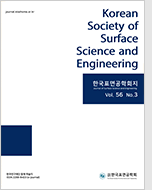
- Past Issues
- e-Submission
-

2021 Impact Factor 1.766
5-Year Impact Factor 1.674
Editorial Office
- +82-2-563-0935
- +82-2-558-2230
- submission@kssse.or.kr
- https://www.kssse.or.kr/

2021 Impact Factor 1.766
5-Year Impact Factor 1.674
The Korean Society of Surface Science and Engineering 2023;56(3):201-207. Published online: Jun, 27, 2023
DOI : 10.5695/JSSE.2023.56.3.201
Eu3+-doped SnO2 (SnO2:Eu3+) phosphor thin films were grown on quartz substrates by radio-frequency magnetron sputtering. The deposition temperature was varied from 100 to 400 ℃. The X-ray diffraction patterns showed that all the thin films had two mixed phases of SnO2 and Eu2Sn2O7. The 880 nmthick SnO2:Eu3+ thin film grown at 100 ℃ exhibited numerous pebble-shaped particles. The excitation spectra of SnO2:Eu3+ thin films consisted of a strong and broad peak at 312 nm in the vicinity from 250 to 350 nm owing to the O2-–Eu3+ charge transfer band, irrespective of deposition temperature. Upon 312 nm excitation, the SnO2:Eu3+ thin films showed a main emission peak at 592 nm arising from the 5D0→7F1 transition and a weak 615 nm red band originating from the 5D0→7F2 transition of Eu3+. As the deposition temperature increased, the emission intensities of two bands increased rapidly, approached a maximum at 100 ℃, and then decreased slowly at 400 ℃. The thin film deposited at 200 ℃ exhibited a band gap energy of 3.81 eV and an average transmittance of 73.7% in the wavelength range of 500 – 1100 nm. These results indicate that the luminescent intensity of SnO2:Eu3+ thin films can be controlled by changing the deposition temperature.
Keywords Thin Film; Transmittance; Photoluminescence.